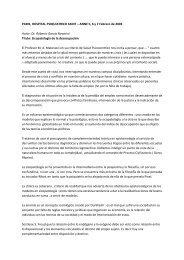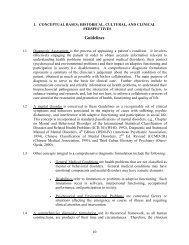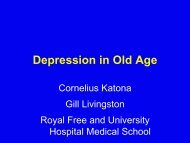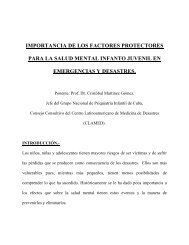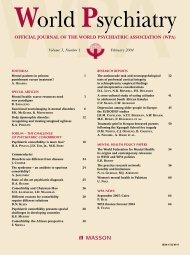ABSTRACTS - World Psychiatric Association
ABSTRACTS - World Psychiatric Association
ABSTRACTS - World Psychiatric Association
You also want an ePaper? Increase the reach of your titles
YUMPU automatically turns print PDFs into web optimized ePapers that Google loves.
cologic treatment options are now available to treat BED. These<br />
agents include selective serotonin reuptake inhibitors, the anti-obesity<br />
agent sibutramine, and the anticonvulsant topiramate. This paper<br />
reviews the current clinical evidence for these and other medications<br />
in the treatment of BED.<br />
TL5.<br />
ENVIRONMENTAL CAUSES OF MENTAL DISORDER<br />
M. Rutter<br />
Institute of Psychiatry, London, UK<br />
Half a century ago, there was a general acceptance of the view that<br />
environmental causes of mental disorder were strong and determinative.<br />
That view has been seriously challenged and it has become clear<br />
that the strong and deterministic notion of environmental causation<br />
was extremely misleading. Nevertheless, powerful research strategies<br />
have demonstrated the reality and importance of environmental causation.<br />
This paper reviews the challenges and how they have been<br />
met; summarises the ways in which the early views have had to be<br />
modified; and indicates the current state of the art and the challenges<br />
that remain. Six issues constitute the main focus: a) the identification<br />
of key elements of risk, together with the appreciation that the casual<br />
effects may be prenatal as well as postnatal, and include both physical<br />
and psychosocial hazards; b) the recognition that with multifactorial<br />
disorders there cannot be any single “basic” cause; rather the<br />
need is to identify key individual causal components and the direct<br />
and indirect pathways involved in the causal process; c) the reality of<br />
reverse causation, as exemplified by child effects on parenting; d) the<br />
need to consider possible genetic mediation of risks associated with<br />
specific environments; e) the role of “natural experiments” in testing<br />
causal inferences; f) the heterogeneity of response to environmental<br />
risk, the reality of resilience and the importance of the effects of environments<br />
on biology and the need to consider how “environments get<br />
under the skin”.<br />
TL6.<br />
THE CAUSES OF SCHIZOPHRENIA: THE STRIATUM<br />
AND THE STREET<br />
R.M. Murray<br />
Institute of Psychiatry, London, UK<br />
Much evidence suggests that the final common pathway to at least the<br />
positive symptoms of schizophrenia is dopamine dysregulation in the<br />
striatum. It is clear that an individual can develop this dysregulation<br />
consequent upon a number of different aetiological factors. Firstly, we<br />
have known for many years that inheritance contributes, and the evidence<br />
from the plethora of molecular studies over the last 6 years suggests<br />
that in most cases this operates through the interaction of a number<br />
of genes of small effect. However, in a small proportion of cases, a<br />
copy number variation may play a major role possibly through impairing<br />
neurodevelopment. Certainly, some pre-schizophrenic children<br />
have cognitive and neuromotor impairments, and at first presentation,<br />
many individuals with schizophrenia have obvious brain structural<br />
and neuropsychological abnormalities. Furthermore, the risk-increasing<br />
effect of obstetric complications has been demonstrated for schizophrenia,<br />
and these are known to be associated with both structural<br />
brain and cognitive abnormalities and with dopamine dysregulation.<br />
Thus, a second aetiological pathway implicates deviant neurodevelopment.<br />
The excessive use of stimulant drugs and cannabis also<br />
increases risk of schizophrenia, and once again this appears to be via<br />
their effect on striatal dopamine. Finally, there is increasing evidence<br />
implicating exposure to a number of social factors, including migration,<br />
urbanisation, and possibly childhood maltreatment. Of course,<br />
in many patients, more than one of these risk pathways is involved,<br />
and a combination of genetic, developmental and social factors project<br />
the individual over the threshold into illness.<br />
TL7.<br />
LONG-TERM MANAGEMENT OF DEPRESSION:<br />
THE ROLE OF PHARMACOTHERAPY<br />
AND PSYCHOTHERAPIES<br />
M.E. Thase<br />
University of Pennsylvania School of Medicine and Philadelphia<br />
Veterans Affairs Medical Center, Philadelphia, PA, USA<br />
This paper deals with the treatment of recurrent major depressive disorder,<br />
focusing on strategies for prevention. There is broad consensus<br />
in practice guidelines that virtually all patients who respond to antidepressant<br />
medications should receive a 6 to 9 month course of continuation<br />
phase therapy to reduce the risk of relapse and that patients<br />
who have experienced three or more lifetime depressive episodes<br />
should receive a longer course of maintenance phase therapy to prevent<br />
recurrent illness. For those who do not obtain a full remission<br />
during acute phase therapy, there is increasing evidence that simply<br />
continuing the incompletely effective strategy is not sufficient to offset<br />
the risk of relapse. With respect to maintenance phase therapy,<br />
there are surprisingly few studies of truly long-term courses of pharmacotherapy<br />
(i.e., across 2 or more years). It does appear that all<br />
medications with established short-term efficacy are also significantly<br />
more effective than placebo for prevention of relapse or recurrence.<br />
There is also evidence that various forms of cognitive behavior therapy<br />
(CBT) have some degree of enduring prophylactic efficacy and<br />
may reduce the risk of recurrent illness following withdrawal of antidepressant<br />
medications. Although studies of interpersonal psychotherapy<br />
(IPT) have yielded mixed results, the value for ongoing<br />
monthly sessions of IPT – in lieu of pharmacotherapy – has been<br />
shown in studies of adults under the age of 70, particularly when therapeutic<br />
focus is maintained on key areas of interpersonal vulnerability.<br />
Areas of controversy are also discussed, including questions pertaining<br />
to tachyphylaxis and whether or not the benefit-risk profile of<br />
longer-term antidepressant therapy has been exaggerated.<br />
TL8.<br />
WHAT IS A MOOD STABILIZER<br />
P.E. Keck, Jr.<br />
Lindner Center of HOPE and University of Cincinnati College<br />
of Medicine, Cincinnati, OH, USA<br />
The term “mood stabilizer” first entered the scientific lexicon in 1960,<br />
and did not refer to lithium, but rather to an obscure first generation<br />
antipsychotic agent then in development. This may have been prescient,<br />
however, as pharmacologic agents from different classes and<br />
different therapeutic designations have increasingly come to be<br />
described as mood stabilizers. Mood stabilizers have, in turn, been<br />
conceptualized as treatments for bipolar disorder, although the<br />
course of major depressive disorder for many patients suggests that<br />
this latter illness could benefit from mood stabilizing concepts as<br />
well. This paper considers the question of what a mood stabilizer is in<br />
the context of definitions formulated by investigators in the field of<br />
bipolar disorder, and in the light of evidence from randomized, con-<br />
2 <strong>World</strong> Psychiatry 8:S1 - February 2009




